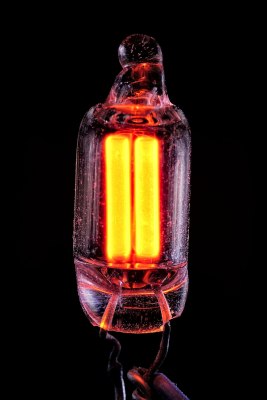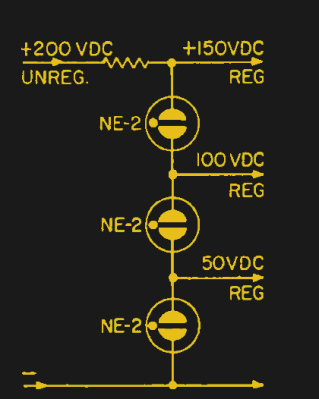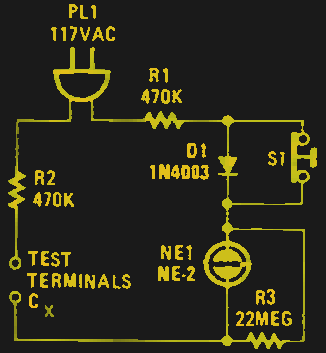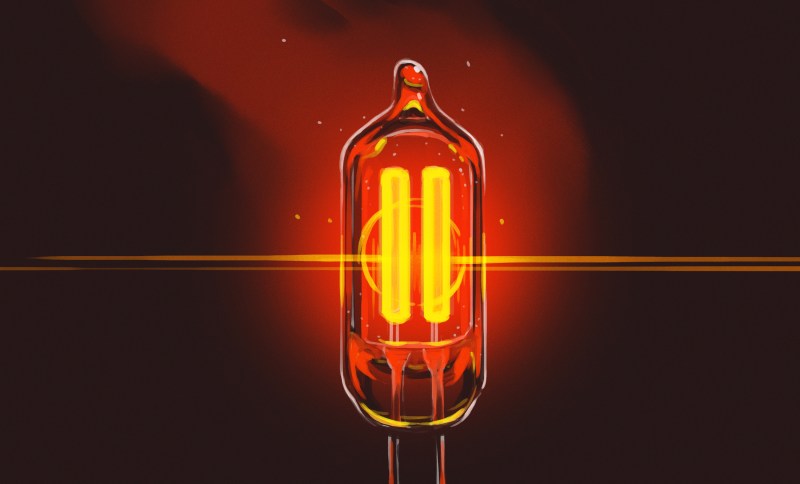When you think of neon, you might think of neon signs or the tenth element, a noble gas. But there was a time when neon bulbs like the venerable NE-2 were the 555 of their day, with a seemingly endless number of clever circuits. What made this little device so versatile? And why do we see so few of them today?
Neon’s brilliant glow was noted when William Ramsay and Morris Travers discovered it in 1898. It would be 1910 before a practical lighting device using neon appeared. It was 1915 when the developer, Georges Claude, of Air Liquide fame, received a patent on the unique electrodes suitable for lighting and, thus, had a monopoly on the technology he sold through his company Claude Neon Lights.
However, Daniel Moore in 1917 developed a different kind of neon bulb while working for General Electric. These bulbs used coronal discharge to produce a red glow or, with argon, a blue glow. This was different enough to earn another patent, and neon bulbs found use primarily as indicator lamps before the advent of the LED. However, it would also find many other uses.
How It Worked

There are two electrodes within, an anode and a cathode. When a DC voltage excites the bulb sufficiently, a glow forms around one electrode. AC makes both electrodes glow alternately. The striking voltage changes based on ambient light or radioactive exposure, as well as the bulb’s gas mix and pressure.
Until the strike voltage occurs, the bulb is effectively an open circuit. When it does strike, however, the resistance goes down and will sustain even at a lower voltage. Like an LED, current limiting is essential, or the bulb will burn out. The NE-2, arguably the most common neon bulb, triggers at 90 V, nominally, and will conduct until the voltage drops to about 60 V.
So It Lights Up?
The lighting up is good, but you do need a lot of voltage to get it going. The bulb will easily light up from 120 V line voltage, for example. But the really interesting property is that the bulbs, when glowing, exhibit negative resistance. That is, as current increases, voltage decreases.
You can also make the bulbs operate in a bistable mode, where they can work in logic circuits. They weren’t common, but some bulbs had special features for logic use. These bulbs were not made to glow necessarily, and sometimes had a third wire used as a control electrode.
Since the gas inside the tube can ionize, neon bulbs can also detect things like light, microwaves, or heavy electrostatic fields. They can even pick up audio.
What Could You Do?
Of course, the normal application was to use the devices as a lamp, like you’d use an LED today. Power pilot lights were common. Special neon lights looking like digits form the basis of nixie tubes.
Another neat display trick was the “blown fuse” indicator. Fuse holders often had neon bulbs in them that connected across the fuse terminals. In normal operation, the voltage across the fuse was practically zero, so the bulb stayed dark. But if the fuse blew, you’d have 120 V across the bulb, which would then light up. A high-value resistor prevented any significant current from flowing.
By far the most common non-lighting use was as a part of a relaxation oscillator. Consider a circuit with a resistor and a capacitor, but the capacitor has a neon bulb across it. The capacitor will charge until it hits the neon bulb’s trigger voltage. The bulb will light and discharge the capacitor until it drops below the holding voltage for the bulb. Then the process starts over. You could use neons to make a clock.
Long History

[E. Norbert Smith] wrote about the “1001” uses for the NE-2 — probably not an exaggeration, but [Smith] didn’t get that many in the article — in a 1965 Elementary Electronics magazine article.
The circuits he shows include a 50 V regulated power supply. (Regulators weren’t held to the same standard in those days as we would expect now.) Need 150 V? Use three of them. Or put them in parallel to improve regulation performance.
Some of the circuits are probably not useful if you aren’t building with tubes. And, of course, if you aren’t building with tubes, you are less likely to have the high voltages you need, so there is that.
He also covers the classic self-indicating fuse and the relaxation oscillator. Of course, if you can make one neon bulb blink, you can also make two blink alternately. Blink it fast enough and you can make a code practice oscillator with just a few parts and a 90 V battery.

If you wondered how neon bulbs could handle logic, that same article will answer that question, too. Just be aware that a logic 1 is 10 V — not a problem — but a logic 0 is -10 V. The nice thing about demonstrating logic circuits with neon bulbs is that you don’t need a logic probe or scope to see the state of the machine.
There were many other ways to use these bulbs. Since the trigger voltage was stable, you could use it as a voltage indicator if you coupled it with a voltage divider. In fact, many cheap AC socket testers still work this way. A typical circuit for a capacitor checker could be found in “36 Time Tested Circuits,” a book from Popular Electronics.

The capacitor is hooked up to the AC line via some 470 kΩ resistors. If you connect a capacitor to it, the neon bulb should light up. If not, it is open. When you push the button, you switch to DC, and you should be able to see one side of the neon bulb dim. If it doesn’t dim or doesn’t go all the way off, the capacitor is shorted or leaky. Supposedly, you could get a feel for the value of the capacitor by how long it took half of the bulb to go out. Makes you appreciate your digital capacitance meter, right?
Why Gone?
Why do you so rarely see neon bulbs today? They are still around, but the number of circuits you have where you have the requisite 100 V or so to drive them is not what it used to be. On top of that, as an indicator, an LED is usually a far better choice.
If you want negative resistance, your choices are less obvious. Some special diodes present a negative resistance in certain operating regimes, and you can coax the behavior from some transistors. However, as a matter of practicality, today, you’d probably just use an active switch and be done with it, especially for an oscillator circuit. Then again, if you really want an oscillator, as we are always reminded, you can do it with a 555, among other methods.
We have no doubt that [Smith] was right. There are probably at least 1,001 different uses, but you get the idea. Did you use an NE-2 for something interesting? Let us know about it in the comments. Still want more neon bulb circuits? We’ve seen plenty.















My dad built some beautiful ring oscillators with neon bulbs, where the bulb blinker progression is set by the bulb breakdown. As a result I have a box of 2000 (minus what he used on his displays) neon bulbs and they’ve been fun to play with. The wiring that they use is harder than average to solder, but one fun thing is you can bias them to trigger into breakdown with a laser pulse, and with some careful current limiting, you can get it to flash on, deplete the charge in the cap, turn off, and wait for the next laser pulse, like a really bad geiger counter but for lasers.
The effect doesn’t even require a laser. I have a surge protector with a neon bulb for a power indicator. I thought the bulb was dead, but it comes on when light shines on it. I wouldn’t be surprised to find out that the effect, properly controlled, could be used to make a (terrible?) optical isolator.
As it stands, the failing neon bulb can tell me when the light is on…if the light is shining on it.
This is a common problem for people who built neon clock, it might stop working in the dark. Most solve it with a couple of blue LEDs which in my opinion ruin the nice orange glow
You could use a deep UV LED with a Wood’s filter
Re: Optical isolator. Back in the day, when you had a landline phone, you could only have approved, leased phones in your house. If you obtained a black market phone and hooked it up to your line, you could expect a call from the phone company and they would not be nice about it. They detected the extra phone(s) by the impedance of the coil that operated the ringer.
I got a phone at a hamfest (I was maybe 14 at the time) and took the bell out, and used it in my room at my parent’s house. The only problem was that it could be hard to hear the legit phones ringing in another room and know to answer.
The bell is rung by a fairly high voltage, well over an NE-2’s firing voltage. So I hooked a neon light with a current limiting resistor across the line. When the phone rang, the light would light up, when it was not ringing, it looked like an open circuit to the phone company when they searched for illegal phones.
Of course, the light wasn’t bright enough be useful by itself, so I put a phototransistor up against it and sealed the package together with heat-shrink. With another transistor, a battery, and a Mallory Sonalert (I don’t think the make those anymore, a shame) a very loud tone would go off when the phone rang. We ended up doing this for other phones including one in the garage; the phone company never knew a thing. This went on for years.
Nice anecdote, thanks!
I also used old surplus phones to hide from Ma Bell, but I had an old tube amp and listened to the line for ring pulses. One side effect was you could hear a click and hum noise before the first ring. No one else in the house would know you picked up.
Bulbs intended as circuit components instead of indicators had a small radioactive source so they would work reliably in the dark.
See also the decatron, which is a neon-based storage device capable of storing a single base 10 digit. It can be prompted to count up or down and the value can be sensed. These can be used to build base 10 computers; for example, the WITCH at the Bletchley Park computing museum.
I recall from my high school days that Decatrons were also used as event rate dividers on geiger counters.
One can still buy tiny neon bulbs on AliEx, in case you want some.
And one can use them to calibrate spectrometer (because CFL are also getting harder to come by). Even though argon might be a better choice.
Btw, starters for fluorescent tubes are usually just neon/argon bulb with a small cap in parallel. In case you were looking for some bigger neon bulbs.
In any case, thanks for the article. :-)
Coloured ones as well, done by a phosphor coating. Usually only green & blue; I’ve got some purple ones somewhere.
…and white.
Neon indicators certainly aren’t rare. Last month I needed some 120 volt illuminated rocker switches and almost every one in stock on Digikey and Mouser was neon. You just don’t see them as much because so much stuff is low voltage these days.
Speaking of being light sensitive… I’ve see a few older neon bulbs flicker when the room lights were off, but light steady when the lights were on. It’s a pretty cool effect.
My first neon project was a ring indicator for my phone….so I could turn off the mechanical ringer ( and its ringer load) and still see an incoming phone call and not get charged for an illegal phone on the line. (I guess the MaBell breakup wasnt all bad)
No mention of the Radio Shack Science Fair Goofy Light P-Box kit? It’s worth studying how they sequentially flash neons.
https://www.nutsvolts.com/uploads/magazine_downloads/NeonLamp-Information.pdf — page 12 has a representative circuit.
Forrest M Mims! OMG! Thank you.
I’m not into neon but there are at least 6 of them in the room I’m in.
All of them indicators, but in that use certainly not rare, as Cody points out too.
I have a light switch with it built in. Plus those neon voltage testers.
For further edification, read the General Electric Glow Tube Manual, available at a number of web sites. Some chapter headings: Physics and Characteristics, Relaxation Oscillators, Logic and Computer Applications. This text is brilliant, and has glowing reviews. Enjoy! Build!
A really good piece of reference material.
Another is a (approximately) 160 page book, “”Applications of Neon Lamps and Gas Discharge Tubes” , by Edward Bauman, Signalite, Inc.
I could have sworn I saw this on HaD but I searched and it didn’t come up. https://www.youtube.com/watch?v=M6P-adLrXBI Great information!
I carry a couple of NE-2 bulbs in my engineering tool kit. Very handy for HV and RF detection (before I poke a finger into the ckt).
Hams used to test for standing waves on open wire transmission lines use NE2s. Obviously not for the values, but for the location of the voltage peaks.
I read an article once where they used neon bulbs in logic circuits – and / or / not gates of neon bulbs. I have not been able to find it since though.
Just make sure there’s a 100k resistor in series with the NE-2 and a 120v wall socket. Otherwise, the bulb will explode and in an instant, glass will be everywhere. (Don’t ask me how I know that. ;-)
That current limiting resistor is a MUST, believe me!
Just as any arc-discharge lamp (think carbon-arc lamp; fluorescent tube; etc.), the neon indicator lamp is a negative-resistance device and will self-destruct without a ballast resistor / impedance as a part of its excitation circuitry.
Here’s a video of a touch-sensitive neon tube used in elevator buttons back in the day: https://www.youtube.com/shorts/kXbaP88k6EY
There are some dekatron and nixie videos too…all really old.
I’ll admit I have a real soft spot for these. I’m not really into vintage electronics, or electrical gear – its just they happen to emit my favourite colour – a very warm yellowy-amber, that’s quite difficult to recreate with LEDs (you can get close, but even with RGBA, its just not there). As such I spent far too much time trying to make very small, efficient >70V generators just to power a single NE2.
Cool article, and it just reminded me that I need to revisit these – I too have a a bag of about 30 that are sitting in a draw [i]not[/i] glowing..
Here in Oz not too many years back, one of our electronics chain component suppliers (J****r) offered me a “mains operated” panel bezel light. This was not actually a real neon but a LED with (IIRC) a resistor. I really wanted a real neon as I was using it in a high voltage project. I was not happy but bought it anyway, and I lucked onto a real neon panel light before I got to use the modern thing.
I just had a look and they seem to have a 90v and also 120V real neon bulb now, to be used with a resistor, but just the plain bulb not in a bezel housing.
So if you are looking for a real neon, keep this in mind.
DIACs are somewhat similar in their behavior (breakdown at higher voltage, then conducts until lower voltage). Unfortunately they are, too, disappearing. For example SMDB3 was recently discontinued.
I’m pretty sure you can make your own DIAC out of an SCR.
“I’m pretty sure you can make your own DIAC out of an SCR.”
Perhaps from two (plus additional components), certainly, but never from one.
Your (explanatory) comments and instructions, please.
“Despite the name, a neon bulb typically has only 99.5% neon…” ??? The 0.5% that isn’t neon means the name isn’t appropriate?
No more inappropriate than the name “lightning bug” is for the firefly…
Microwave oven manufacturers used to use a large array of (totally isolated) neon indicator tubes, similar to the NE-2—arranged in a square or rectangular matrix—to visually display the radiation pattern inside the oven’s cavity.
This was back in the ‘wild west’ days of microwave ovens when manufacturers were creatively trying to get an advantage over the competition, and were playing with the cavity design in order to claim novelty.
…think that manufacturers have standardized on ‘one cavity design per magnetron power output’ strategy, and have saved their creative efforts for packaging (i.e., design glitz) and sales and marketing.
I worked in a lab testing radar components in the 50’s and used an Ne2 on a pencil to check for radiation leaks .